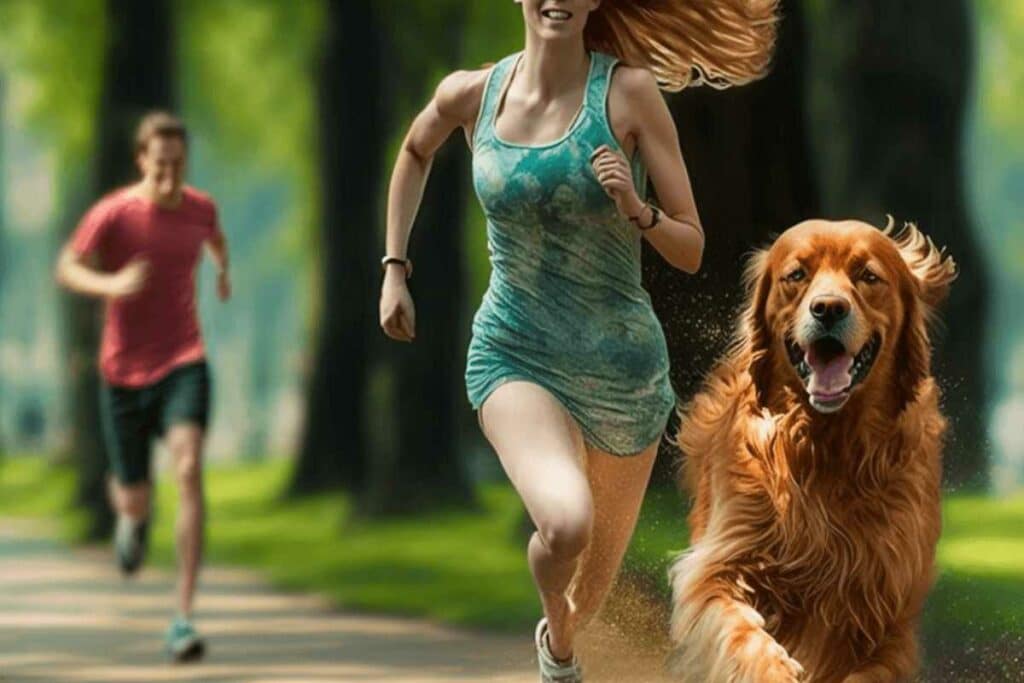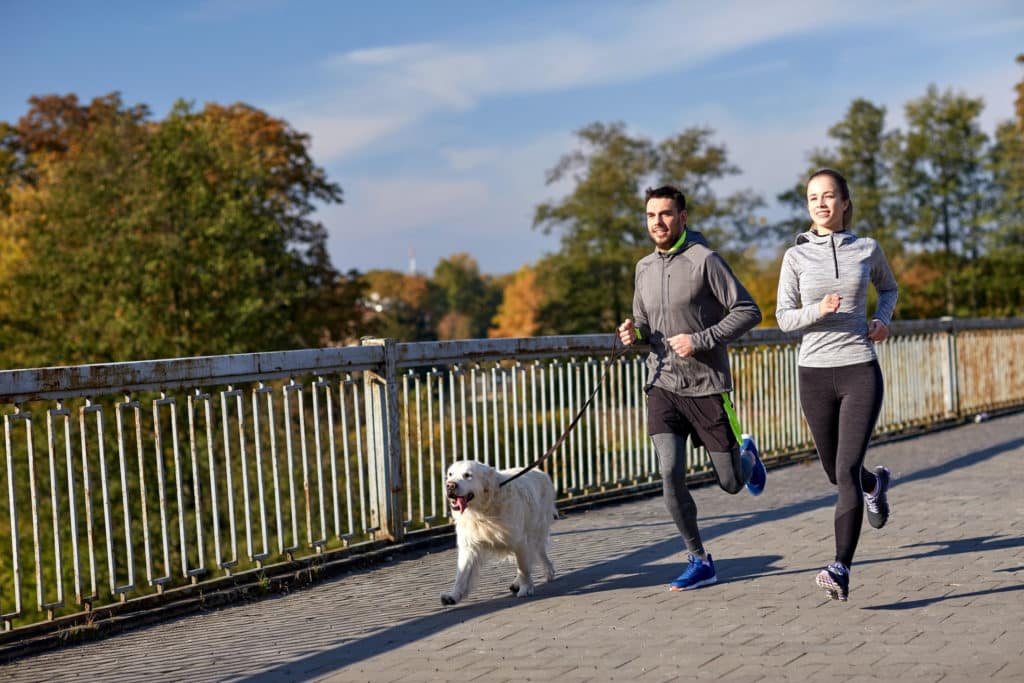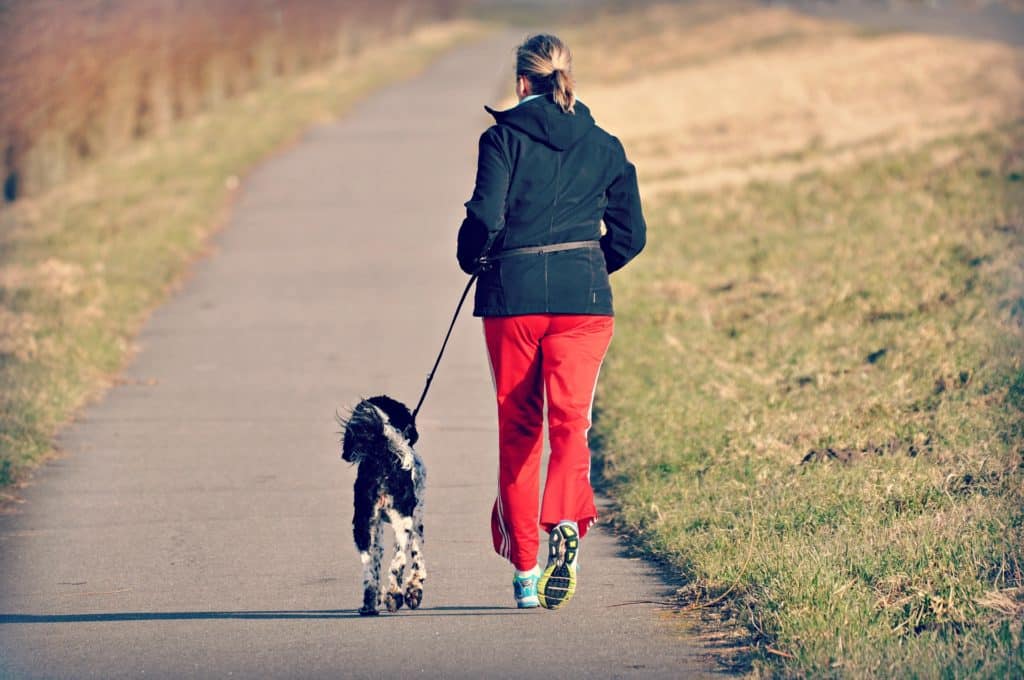Jogging With Dog: These 8 Tips You Should Know
- Claudia Weise
- Updated: 2024-02-07
Want to go jogging with your dog? You'll have a highly motivated running partner at your side in any weather. But your companion's needs come before your running goals! With our easy-to-implement pro tips, jogging will be a pleasure for both of you.

Why Dogs Make Perfect Training Partners
Running is not always fun. Sometimes the inner bastard wins. Most of the time we are never at a loss for excuses: bad weather, bad sleep, bad timing...
It's different with a dog by your side. As soon as you lace up your running shoes, your four-legged running partner runs to the door with excitement. He can hardly wait to jog with you through the woods and fields.
This is pure motivation!
Benefits for Dogs
- Improved physical fitness: Regular jogging strengthens the cardiovascular system, builds muscle, and helps control weight.
- Mental stimulation: Exploring new environments while walking provides mental stimulation through new smells, sounds and sights.
- Balance: Well-trained dogs are often more balanced and show fewer behavioral problems such as excessive barking or destructiveness.
Dogs love exercise. They enjoy spending time with you and love being outdoors. After a certain amount of training, most furry friends will happily accompany you on long walks. This is not only fun for them, but also keeps them fit.
Another advantage: Walking your dog regularly strengthens your bond with him. However, not all breeds are suited to endurance sports.
These Dog Breeds Are Not Suitable for Running
- You should not take a Pug, Pekingese, Bulldog or Boxer jogging. Their shortened noses make it difficult for them to breathe: they don't get enough air when they run. Even walking at a normal pace is often exhausting for these dogs.
- Running is also not an ideal activity for short-legged Dachshunds. Their long bodies make them prone to back problems. Short (!) distances at a leisurely pace are possible if they are in good health.
- The large, cuddly St. Bernards are naturally sluggish. Because of their full bodies, they are more comfortable taking a leisurely walk than jogging.
Ideal Dogs for Runners

Large, active dogs with long legs are the best running partners. It is important that your dog is healthy. It should have no physical limitations.
Here applies: It's best to have a complete health check at the vet before running!
The following dogs are suitable companions for endurance athletes:
- Australian Sheperds (Australian Shepherd Dogs)
- Border Collies
- Dalmantine
- Golden Retriever
- Huskies
- Labradors
- Poodle
- Terriers
- Weimaraner
- Greyhounds etc.
What Requirements Should My Dog Meet?
The most important question is whether your dog is a good running partner. This depends on the breed of your dog. Your dog's age and physical condition also play an important role.
A middle-aged dog is the best companion. Is your dog overweight? Then you should take it extra slow.
Older dogs are often still very active. But as they get older, your dog's performance will decline. Make sure you don't overwhelm him with the length of the trails.
It is also important: Your dog should know the basic commands, be well behaved on the lead and heel can run on a lead. This helps to avoid accidents and makes jogging more enjoyable for both sides.
Every dog is different, and while some dogs are natural runners, others prefer shorter or slower walks. Watch for signs of fatigue or disinterest and adjust pace and distance accordingly.
Before you start jogging, it is a good idea to consult a veterinarian. Your veterinarian can evaluate your dog's suitability for this type of activity and make specific recommendations based on your dog's breed, age, and health.
When Can My Dog Start Running?
Walking is too strenuous for puppies. This is true for all breeds. Wait until their muscles are fully developed and their bones have finished growing before jogging together. Your furry friend should be at least one-year-old.
Most dogs reach the end of their growth phase between 12 and 18 months of age. In large and very large breeds, this time may be later, often between 18 and 24 months.
It is important that the growth plates are fully closed before beginning regular jogging to minimize the risk of joint and bone damage.
Even if your dog is the right age, start with short distances and increase slowly. This will help your dog become accustomed to the new activity without overexerting him.
The Duration
How long you can jog with your dog depends on several factors, including your dog's age, breed, condition, and health. There is no one-size-fits-all answer because every dog is different. However, you can follow these guidelines to ensure that jogging remains enjoyable and safe for your dog:
Start Slowly
Start with short distances: When you first start jogging, it's important to start with short distances and build up slowly. A good place to start is a 5 to 10 minute run, depending on your dog's fitness level.
Watch Your Dog
Watch for signs of fatigue: excessive panting, slowness, stopping, or disinterest in continuing the walk are signs that your dog needs a break or has had enough for the day.
Respect His Need for Rest
Younger and livelier dogs recover faster and can run longer distances, while older dogs or dogs with health problems need shorter and more moderate runs.
Increase Duration
As the dog becomes accustomed to jogging, the duration can be slowly increased as long as the dog is comfortable and shows no negative reactions. Some healthy, active dogs can eventually jog for 30 minutes to an hour, but this should be done gradually.
Regulation and Adjustment
Take regular breaks: Make sure you take regular breaks to hydrate and rest while running, especially on longer distances.
When to Pause or Even Stop Running
Observe your dog as he walks. Is he panting evenly? Is he enthusiastic? Then everything is fine. His mucous membranes and tongue should be pink.
However, if you notice that his tongue and gums look pale or even bluish, it's time to take a break. This is also true if your dog is coughing, tired, or showing signs of exhaustion. When in doubt, stop the run and consult your veterinarian.
Preparation: These Are the 7 Precautions You Should Take
Walking together on soft ground such as forest and field paths is ideal. It is also easy on the joints! If you're lucky, you'll be relatively alone. You'll get some oxygen, some exercise, and you'll enjoy being together. That's fun!
Avoid extreme weather conditions. Temperatures that are too high or too low can be dangerous for your dog. Mild temperatures are ideal. In summer, the early morning or late evening hours are ideal for exercise to avoid the heat.
High humidity can make it harder for your dog to cool off, as sweat evaporation (dogs pant to release heat) is less effective. Hot asphalt roads can burn your dog's paws, while icy or very cold ground can cause frostbite. Choose soft, paw-friendly surfaces such as wooded trails or parks.
A comfortable harness is safer and more comfortable for your dog than a collar. A leash that is not too long will give you control without restricting you or your dog. A short warm-up, such as a quick walk or light play, can help prepare your dog's muscles for the activity ahead.
Be aware of the people and animals around you. Not all people are comfortable around dogs, and not all dogs get along with others. Obey local leash laws and keep your surroundings clean by picking up after your dog.
It's a good idea to let your dog do its "business" before you start jogging. A dog that can do its business before jogging is likely to be more comfortable while jogging. This will prevent him from feeling uncomfortable during the jog or having to stop to do his business. This can disrupt the flow and rhythm of the activity.
However, there are some preparations you should make for your dog before you go.
1. Protection From Ticks
Bushes and forest edges are Ticks-Hotspots. Remember to protect your pet from parasites. This will ensure that he doesn't bring home any uninvited guests.
2. Sunshade
Does your dog have a white coat? Sunscreen will protect unprotected areas of skin, such as the ears, from sunburn. Apply a thin layer about 20 minutes before walking.
3. Water
Exercise makes you thirsty. It's best to carry a water bottle with you. You can find versions with an integrated silicone cup in stores. Your four-legged friend can sip from it during breaks in the run. This way, you can refresh yourself from time to time on the way.
4. Safety
Walking at dusk increases the risk of being overlooked. Equip yourself and your pet with reflectors. Luminescent harnesses and leashes are available. They have reflectors that charge in the sun and glow in the dark.
5. Light
A headlight makes sure you can see what is in front of you.
6. For Emergency
To be able to react quickly in the event of an accident, you should have a First aid kit and carry your cell phone. Be sure to save the number of your family veterinarian and the veterinary clinic.
7. Fecal Bag
Dispose of your four-legged friend's droppings. Dispose of the Bag properly and do not throw them into nature (they do not rot).
Jogging Equipment: Why a Chest Harness Is Better

When jogging, a padded chest harness and a special jogging leash are better for your dog than a collar with a "regular" leash. The reason is simple: jerky pulling, such as when changing direction, can lead to compression of the cervical spine. A jogging leash is long and flexible. It gives the dog more freedom of movement. This prevents injury.
Another advantage: You can easily attach the leash to your hip belt. This keeps your hands free while you run. You can also store or attach your water bottle, tissues, and other small items to this strap.
Does your dog follow you everywhere? Maybe you can let him run off leash from time to time. Be sure to check your state's laws!
8 Tips for You and Your Dog
That's how you start training together:
1. Do Not Start Immediately After Eating
Wait at least two hours after feeding before going for a run. Your dog needs this time to digest the food. This reduces the risk of gastric torsion, which can be life-threatening. That's why you should go easy on the treats when you're out and about.
2. Warm Up
Before you start exercising, you should warm up. This will help prevent injuries. Not only your muscles, but also your dog's muscles need time to adjust to the upcoming exertion. You can repeat the commands "sit", "down" and "give paw" to your dog.
3. Check Chest Harness and Leash
Double-check the fit of your dog's harness. Make sure the leash is securely fastened between the harness and your belly strap. Fill your water bottle. Don't forget the first aid kit, tissues and your cell phone.
4. Choose Short, Easy Routes
Keep stretches short at first. Ten minutes is a good time for beginners. Choose wide paths and easy routes so you can walk side by side. Your dog may want to stop and sniff. He knows this from your walks. Just walk for a few minutes in between, run in place, or use the time for stretching.
5. Adapt to the Dog’s Fitness Level
How fast and how far your dog runs depends on his condition and his "trot speed". It's best to adapt to that. Is your dog lean and eager to run, but untrained? Then slowly increase the distance you run together.
6. Be Patient When Mistakes Are Made
It is important not to overwhelm your dog. It takes a while for you to get used to each other. Praise your dog when he does something well. Mistakes are not so important. The more fun he has, the better your walk will be. Be patient with your companion and enjoy your time together.
7. Take Breaks
Don't forget to take breaks. Especially in the summer, plan to stop for a drink in a shady spot and give your furry friend a break. Fresh water sources are great for refilling the bottle on the fly.
8. Do Not Forget Paw Care
Asphalt and gravel roads with sharp pebbles are not ideal surfaces for dogs. In the summer heat, your dog may burn his paws on the road. Check your dog's paws after every run.
If they are sore, rub them with a moisturizing cream or deer tallow ointment. You can massage it in before, during and after exercise.
If you walk your dog through road salt in the winter, paw care is also a must: wash the paws in lukewarm water. Don't forget to wash between the toes. Then dry them thoroughly!
The Speed
The right pace for jogging with your dog depends on several factors, including your dog's breed, age, size, condition, and overall health. There is no universal pace that works for all dogs, so it is important to respond to your dog's individual needs and cues.
Smaller dogs have shorter legs and need to move faster to keep up, so a slow pace can still be fast for them. Larger dogs often find it easier to maintain a faster pace, but that doesn't mean they should always run faster. Large breeds can be more prone to joint problems, so it's important not to overexert them.
Excessive panting, slowing down, stopping or trying to sit down are clear signs that your dog needs a break or that the pace is too fast.
The ideal pace is one at which your dog can walk comfortably alongside you without rushing or pulling too hard. Some dogs prefer to trot, while others are more comfortable jogging at a slower pace.
Younger and more energetic dogs can often run at a faster pace and for longer distances, provided they are healthy and well trained. Older dogs or dogs with health problems may need a slower pace and shorter distances. Their stamina and agility may be limited.
Especially if you and your dog are jogging together for the first time, start with a slow pace and short distances. As you both get fitter, you can increase your pace.
Be aware of the outside temperature: Dogs cannot regulate their body heat as well as we humans can. On hot days, slow down and move to cooler times of the day. The right pace may vary from day to day depending on many factors such as the weather, time of day, and your dog's overall energy and health.
Sore Muscles in Dogs?
Yes, just like humans, dogs can get sore muscles from jogging, especially if the activity is more intense or prolonged than usual. Muscle soreness is caused by overexertion of the muscles, which results in micro tears in the muscle cells. This is a normal part of muscle growth and strengthening, but can cause temporary pain and stiffness.
Signs of Sore Muscles in Dogs
- Stiffness or slowness in standing up
- Visible hesitation when climbing stairs or jumping
- Changes in gait or visible discomfort when walking
- Decreased enthusiasm for physical activities they normally enjoy.
Prevention and Treatment
- Slow entry: Start with shorter, less intense jogging sessions and gradually increase the duration and intensity to build endurance and muscle strength.
- Warm up: A short warm-up with a walk or gentle play can prepare your dog's muscles for the upcoming activity and reduce the risk of muscle soreness.
- Drink plenty of fluids: Make sure your dog drinks plenty of water before and after a run to keep his muscles hydrated and functioning properly.
- Adequate nutrition: A balanced diet rich in essential nutrients supports muscle recovery and strengthening.
- Rest and relaxation: Give your dog plenty of time to recover after an intense run so that his muscles can regenerate.
If you suspect your dog has soreness, it's important to give him a break from strenuous activity until he's fully recovered. If your dog's stiffness or discomfort persists or worsens, take him to the veterinarian to rule out other possible causes.
Overall, it is important to listen to your dog's cues and adjust physical activity accordingly to avoid overexertion and muscle soreness. By slowly increasing the load, you can help your dog improve his fitness in a safe way.
My Conclusion
Running with a dog is great fun if you take it slowly. The joy of exercise should be the main focus.
Do you enjoy jogging with your dog or are you planning to? Then we are interested in your experiences and opinions. Just write in the comments below.

I'm editor-in-chief at Hundeo and when it comes to dogs, my heart beats faster. My goal is to publish the best dog guides on the web. There is a lot of passion in every article and I welcome any feedback to constantly improve our content.
Share Now:

